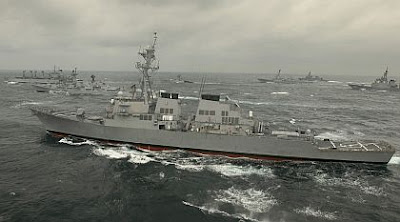Posted by
John Keller
THE MIL & AERO BLOG, 2 April 2013. We've seen threats from
North Korea against U.S. military and civil interests over the last week that are so astonishing as to spill over into the absurd. Targets reported to be on North Korea's list for potential
nuclear missile attacks include San Diego, Washington, and even Austin, Texas.
North Korea over the past week also has threatened nuclear missile attacks on U.S. military bases in Hawaii and Guam, as well as military and civil targets in South Korea.
Beyond providing a field day for satirists on Twitter, the threats against Austin are considered to be -- to put it mildly -- overblown. There is no evidence that North Korea has the rocket or missile-guidance technology to land a nuclear warhead in San Diego, let alone Austin or Washington.
Still, there is some reason for concern.
First off, what do we know? We know that North Korea has demonstrated the ability to build a nuclear warhead, based on observed atomic tests in North Korea. Would these nuclear devices work in the real world? Does North Korea have sufficient controlled detonation capability that would ensure the nuclear warhead exploded when it's supposed to? That we don't know.
Second, we know that North Korea has some intermediate-range ballistic missile technology, most likely based on Soviet SCUD missiles with refinements from North Korean missile research and development. These missiles may be capable of reaching South Korea, Japan, and possibly U.S. military installations on Okinawa.
Based on supposed North Korean ballistic missile technology, Guam most likely is outside the range of even the most advanced North Korean ballistic missiles. Also outside the envelope, most likely, are Hawaii and the outermost Aleutian islands of Alaska.
So we know North Korea has nuclear warhead and intermediate ballistic missile technology. It's a stretch, however, to assume that North Korea has the ability to put a nuclear weapon on target with a ballistic missile.
Nuclear tests and missile launches do not demonstrate the ability to put warhead on target. Those depend on missile guidance and munitions fusing technologies, and those in North Korea we know little about.
Now is it possible that North Korea could launch a nuclear warhead on a ballistic missile with any accuracy at targets in Japan and Okinawa? Sure it's possible. Is it likely? That's another question entirely.
Now let's add some things to the mix. The U.S. Navy reportedly has sent missile destroyer USS John S. McCain -- named for the father and grandfather of the senator from Arizona -- to the Sea of Japan off the North Korea coast. The warship is designed to detect, track, and destroy ballistic missiles like North Korea possesses.
U.S. B-2 and B-52 nuclear-capable jet bombers, moreover, have been reported over South Korea this past week for military exercises. A North Korean missile launch not only has only a questionable chance of reaching its target, but North Korea also would risk massive retaliation from the U.S. and its allies should a launch occur.
Would the North Korean leadership take such a risk? No way to tell for sure. North Korea is led by 30-year-old Kim Jong-un, an unproven leader who has an interest in making himself look strong and decisive among the people he rules. Although he's young and unproven, his people reportedly revere him like a god.
North Korea's world view appears to be a mix of old-style collective communism, religion, and mysticism. A cornerstone of this philosophy is confronting the United States, which North Korea has considered a sworn enemy since the Korean War 60 years ago. Suffice it to say, the North Korean government is kind of nutty, and that country has few friends internationally.
Remember, the Korean war never really ended; the shooting just stopped. No peace treaty ever was signed. There's only a formal truce to keep hostilities from flaring up. North Korea this past week declared that truce over, so in theory a state of war exists now between North Korea on one side and the U.S. and South Korea on the other.
The real threat here is not so much a North Korean-launched nuclear attack in the region, but precarious and shifting politics of the region. Did I mention that North Korea has few friends? Well, one of its only allies is China.
Is it in China's interest to see its little ally go to war with the U.S., China's largest trading partner and a huge financial borrower? Probably not. The U.S. owes China a lot of money, and a regional war might complicate matters. Plus China makes, well, pretty much everything we buy at Walmart these days.
A regional war is in nobody's interest ... but threats are. North Korea historically has got a lot of mileage out of its bellicose threats against the U.S. With China at North Korea's back door, the rest of the world has found it convenient to make nice with North Korea, no matter how fantastic its threats.
If a shooting war starts again on the Korean Peninsula -- and history shows us that wars can get started pretty easily -- could China stay out of it? I don't see how. It would take some strong, stable, reliable diplomacy on the part of the U.S. and China to avoid dangerous escalation, and from what I've seen of the Obama Administration ... well, that's another story.
So here we are. North Korea has nukes, ballistic missiles, and likes to make big threats. The U.S. and China want to keep a lid on to avoid what might come next, and the lines are drawn.
Wanna know how easy wars can start? Read the Guns of August, or see a movie called The Bedford Incident. Things can get out of control before anyone can blink, and then what might happen?
This is why North Korean threats are cause for concern.






